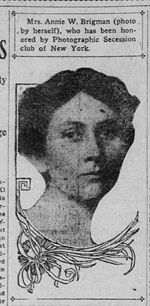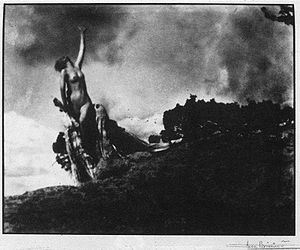
Anne Brigman
Encyclopedia

United States
The United States of America is a federal constitutional republic comprising fifty states and a federal district...
photographer
Photography
Photography is the art, science and practice of creating durable images by recording light or other electromagnetic radiation, either electronically by means of an image sensor or chemically by means of a light-sensitive material such as photographic film...
and one of the original members of the Photo-Secession
Photo-Secession
The Photo-Secession was an early 20th century movement that promoted photography as a fine art in general and photographic pictorialism in particular. A group of photographers, led by Alfred Stieglitz and F...
movement in America. Her most famous images were taken between 1900 and 1920, and depict nude
Nudity
Nudity is the state of wearing no clothing. The wearing of clothing is exclusively a human characteristic. The amount of clothing worn depends on functional considerations and social considerations...
women in primordial, naturalistic contexts.
Life
Brigman was born in the Nuuanu Valley above Honolulu, HawaiiHawaii
Hawaii is the newest of the 50 U.S. states , and is the only U.S. state made up entirely of islands. It is the northernmost island group in Polynesia, occupying most of an archipelago in the central Pacific Ocean, southwest of the continental United States, southeast of Japan, and northeast of...
on 3 December 1869. She was the oldest of eight children born to Mary Ellen Andrews Nott, whose parents has moved to Hawaii as missionaries in 1828. Her father, Samuel Nott, was from Gloucester
Gloucester
Gloucester is a city, district and county town of Gloucestershire in the South West region of England. Gloucester lies close to the Welsh border, and on the River Severn, approximately north-east of Bristol, and south-southwest of Birmingham....
, England. When she was sixteen her family moved to Los Gatos, California
California
California is a state located on the West Coast of the United States. It is by far the most populous U.S. state, and the third-largest by land area...
, and nothing is known about why they moved or what they did after arriving in California. In 1894 she married a sea captain, Martin Brigman. She accompanied her husband on several voyages to the South Seas, returning to Hawaii at least once.
Imogen Cunningham
Imogen Cunningham
Imogen Cunningham was an American photographer known for her photography of botanicals, nudes and industry.-Life and career:...
recounts a story supposedly told to her firsthand that on one of the voyages Brigman fell and injured herself so badly that one breast was removed. Whether this is true or not, after 1900 she stopped traveling with her husband and became active in the growing bohemian community of the San Francisco Bay area. She was close friends with the writer Jack London
Jack London
John Griffith "Jack" London was an American author, journalist, and social activist. He was a pioneer in the then-burgeoning world of commercial magazine fiction and was one of the first fiction writers to obtain worldwide celebrity and a large fortune from his fiction alone...
and the poet and naturalist Charles Keeler. Perhaps seeking her own artistic outlet, she began photographing in 1901. Soon she was exhibiting in local photographic salons, and within two years she had developed a reputation as a master of pictorial photography. In late 1902 she came across a copy of Camera Work
Camera Work
Camera Work was a quarterly photographic journal published by Alfred Stieglitz from 1903 to 1917. It is known for its many high-quality photogravures by some of the most important photographers in the world and its editorial purpose to establish photography as a fine art...
and was captivated by the images and the writings of Alfred Stieglitz
Alfred Stieglitz
Alfred Stieglitz was an American photographer and modern art promoter who was instrumental over his fifty-year career in making photography an accepted art form...
. She wrote Stieglitz praising him for the journal, and Stieglitz in turn soon became captivated with Brigman's photography. In 1902 he listed her as an official member of the Photo-Secession
Photo-Secession
The Photo-Secession was an early 20th century movement that promoted photography as a fine art in general and photographic pictorialism in particular. A group of photographers, led by Alfred Stieglitz and F...
, which, because of Stieglitz's notoriously high standards and because of her distance from the other members in New York, is a significant indicator of her artistic status. IN 1906 she was listed as a Fellow of the Photo-Secession, the only photographer west of the Mississippi to be so honored.
From 1903 to 1908 Stieglitz exhibited Brigman's photos many times, and her photos were printed in three issues of Stieglitz's journal Camera Work
Camera Work
Camera Work was a quarterly photographic journal published by Alfred Stieglitz from 1903 to 1917. It is known for its many high-quality photogravures by some of the most important photographers in the world and its editorial purpose to establish photography as a fine art...
. During this same period he often exhibited and corresponded under the name "Annie Brigman", but in 1911 she dropped the "i" and was known from then on as "Anne". Although she was well known for her artistic work, she did not do any commercial or portrait work like some of her comptemporaries. In 1910 she and her husband separated, and she moved into a house with her mother. By 1913 she was living alone "in a tiny cabin...with a red dog...and 12 tame birds". She continued to exhibit for many years and was included in the landmark International Exhibition at the Albright-Knox Art Gallery
Albright-Knox Art Gallery
The Albright-Knox Art Gallery is an art museum located in Delaware Park in Buffalo, New York. The gallery is a major showplace for modern art and contemporary art. It is located directly across the street from Buffalo State College.-History:...
in New York in 1911 and the Internation Exhibition of Pictorial Photography in San Francisco in 1922.
In California, she became revered by West Coast
West Coast of the United States
West Coast or Pacific Coast are terms for the westernmost coastal states of the United States. The term most often refers to the states of California, Oregon, and Washington. Although not part of the contiguous United States, Alaska and Hawaii do border the Pacific Ocean but can't be included in...
photographers and her photography influenced many of her contemporaries. Here, she was also known as an actress in local plays http://www.loc.gov/chroniclingamerica/lccn/sn85066387/1908-03-31/ed-1/seq-4, and as a poet performing both her own work and more popular pieces such as Enoch Arden
Enoch Arden
"Enoch Arden" is a narrative poem published in 1864 by Alfred, Lord Tennyson, during his tenure as England's Poet Laureate. The story on which it was based was provided to Tennyson by Thomas Woolner....
http://www.loc.gov/chroniclingamerica/lccn/sn85066387/1908-10-26/ed-1/seq-4. An admirer of the work of George Wharton James
George Wharton James
George Wharton James was a prolific popular lecturer and journalist, writing more than 40 books and many articles and pamphlets on California and the American Southwest....
, she photographed him on at least one occasion http://www.loc.gov/chroniclingamerica/lccn/sn85066387/1909-05-29/ed-1/seq-13.
She continued photography through the 1940s, and her work evolved from a pure pictorial style to more of a straight photography
Straight photography
Pure photography or straight photography refers to photography that attempts to depict a scene as realistically and objectively as permitted by the medium, renouncing the use of manipulation....
approach, although she never really abandoned her original vision. Her later close-up photos of sandy beaches and vegetation are fascinating abstractions in black-and-white. In the mid-1930s she also began taking creative writing classes, and soon she was writing poetry. Encouraged by her writing instructor, she put together a book of her poems and photographs call Songs of a Pagan. She found a publisher for the book in 1941, but because of World War II
World War II
World War II, or the Second World War , was a global conflict lasting from 1939 to 1945, involving most of the world's nations—including all of the great powers—eventually forming two opposing military alliances: the Allies and the Axis...
the book was not printed until 1949, one year before she died. Brigman died on 8 February 1950 at her sister's home in El Monte, California.
Photography

Negative (photography)
In photography, a negative may refer to three different things, although they are all related.-A negative:Film for 35 mm cameras comes in long narrow strips of chemical-coated plastic or cellulose acetate. As each image is captured by the camera onto the film strip, the film strip advances so that...
with paints, pencil, or superimposition
Superimposition
In graphics, superimposition is the placement of an image or video on top of an already-existing image or video, usually to add to the overall image effect, but also sometimes to conceal something .This technique is used in cartography to produce photomaps by superimposing grid lines, contour lines...
.
Brigman's deliberately counter-cultural
Counterculture
Counterculture is a sociological term used to describe the values and norms of behavior of a cultural group, or subculture, that run counter to those of the social mainstream of the day, the cultural equivalent of political opposition. Counterculture can also be described as a group whose behavior...
images suggested bohemianism and female liberation. Her work challenged the establishment's cultural norms and defied convention, instead embracing pagan
Paganism
Paganism is a blanket term, typically used to refer to non-Abrahamic, indigenous polytheistic religious traditions....
antiquity. The raw emotional intensity and barbaric strength of her photos contrasted with the carefully calculated and composed images of Stieglitz and other modern photographers.
See also
- PictorialismPictorialismPictorialism is the name given to a photographic movement in vogue from around 1885 following the widespread introduction of the dry-plate process. It reached its height in the early years of the 20th century, and declined rapidly after 1914 after the widespread emergence of Modernism...
- Camera WorkCamera WorkCamera Work was a quarterly photographic journal published by Alfred Stieglitz from 1903 to 1917. It is known for its many high-quality photogravures by some of the most important photographers in the world and its editorial purpose to establish photography as a fine art...
- California TonalismCalifornia TonalismCalifornia Tonalism was art movement that existed in California from circa 1890 to 1920. Tonalist are usually intimate works, painted with a limited palette. Tonalist paintings are softly expressive, suggestive rather than detailed, often depicting the landscape at twilight or evening, when...
- ModernismModernismModernism, in its broadest definition, is modern thought, character, or practice. More specifically, the term describes the modernist movement, its set of cultural tendencies and array of associated cultural movements, originally arising from wide-scale and far-reaching changes to Western society...
- darkroomDarkroomA darkroom is a room that can be made completely dark to allow the processing of light sensitive photographic materials, including photographic film and photographic paper. Darkrooms have been created and used since the inception of photography in the early 19th century...
- ImpressionismImpressionismImpressionism was a 19th-century art movement that originated with a group of Paris-based artists whose independent exhibitions brought them to prominence during the 1870s and 1880s...
External links
- http://museumca.org/ Oakland Museum of California, Oakland, California
- http://www.californiaartclub.org/ The de Young Museum, San Francisco, California

